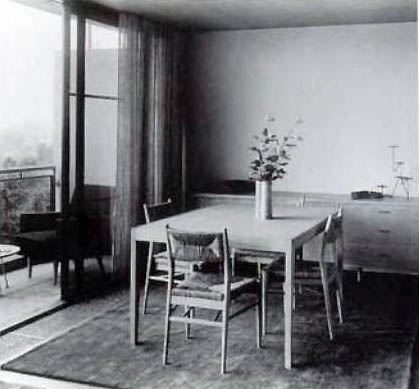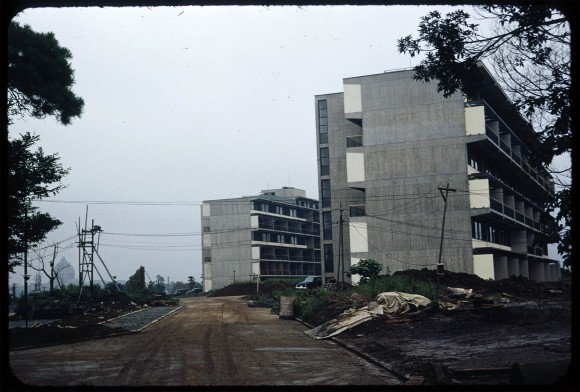While in Tokyo we lived in a serviced apartment in Ark Hills, right next to Roppongi-itchome station. We could see the 1983 US embassy residences opposite Roppongi Dori from our windows. I found some pictures from before they were built. They illustrate how the area has changed since the war and bring back to life two historic buildings that occupied the site before. 30 Nov: Update at bottom of the post
September 1953 – Perry Apartments, left, with Harris Apartments on the right (Antonin Raymond), photograph from Gerald & Rella Warner Japan Slide Collection, reproduced with permission.
Most photos in this post were taken by Gerald Warner, an American diplomat who gained plenty of experience in East Asia before, during and after the war. His vast collection of photographs, mainly from Taiwan, has kindly been digitalised by Lafayette College. It includes some great shots from the 11-acre site the Americans bought from Mitsui for housing their growing embassy staff after the occupation ended in 1951.
May 1951 – Mitsui Imaicho property, view towards Diet
The architect chosen to build here was Antonin Raymond, widely regarded as one of the fathers of Japanese modern architecture. His biography reads like a twentieth-century almanac: He emigrated to the US from the Czech Republic in 1910. After working with Cass Gilbert on the Woolworth Building, he became a disciple of Frank Lloyd Wright, who he accompanied on his trip to Japan building the legendary Imperial Hotel.
Raymond stayed behind in Japan and opened his architectural practice in 1921. He built several embassies and other buildings in his trademark style that married modernism with distinctly Japanese elements. One of his associates, Kunio Maekawa had worked with grandmaster Le Corbusier in his Paris atelier and further connected Raymond with the European avant-garde.
Returning to Tokyo after the war (after a sojourn that saw him work on a project in India), he convinced General MacArthur to have him build the (now demolished) Reader’s Digest Building, controversially located just next to the Imperial Palace moat in central Tokyo. Raymond was often not the most diplomatic architect and reportedly got embroiled in arguments with his clients at times.
Fortunately his practice’s co-owner, Slovak Ladislav Rado, did the talking in order for them to win the commission that would sit atop the hill of the Mitsui estate in central Akasaka. He had to talk with Leland King, who as an architect working for the State Department commissioned embassy buildings around the world. King was one of the main reasons many American representative buildings abroad had the air of the modern and open appeal (although his reach was not universal, as it seems).
The commission’s earlier and more modest specifications quickly morphed into a sixty-unit, seven-storey apartment sited on the crest of the hill. The building was completed in 1952 and named after Commodore Perry, the American naval officer who had made “first contact” with the Japanese exactly 100 years before the apartment building’s completion in 1852.
September 1953 – Perry Apartments Tokyo
The building’s success made King ask the architects to build a slightly smaller identical replica on an adjacent site. It was finished in 1953 and named after Townsend Harris, the first American consul in Japan.
The design of the two buildings was innovative, with flexible interiors and custom-made furniture. These were necessary as the flats were kept relatively small, mainly to be in line with modest domestic building practices. At any rate, American embassy staff that moved in did not like what they saw. They missed American proportions.
Interior design, featuring custom-made furniture (from Loeffler’s Architecture of Diplomacy, see below)
While Rado and Raymond couldn’t impress American expats, they had a lasting impact on young Japanese architects. Perry House was the first multi-storey reinforced concrete building in Tokyo. Structural engineer Paul Weidlinger created an earthquake-proof floor system that caused great excitement, with the Great Kanto Earthquake (1923) still a living memory for most Tokyoites.
September 1953 – Perry and Harris Houses
Probably because of the limited appeal of the flats inside the Perry and Harris Buildings, the Americans decided to tear them down in the early 1980, making space for a brand-new and more spacious development more suited to Americans’ needs. Perry and Harris were kept as namesakes for two new 14-storey towers, standing adjacent to another tower as well as concrete townhouses zigzagging the site.
1980 – Demolition of Perry Apartments by Flickr user Michael Fallsroad (creative commons)
By the time the two apartment blocks were demolished, the whole area had already transformed beyond recognition. Below is a view from Harris House presumably, just before it got torn down. We are facing southeast towards the Hotel Okura South Annex, which had been completed in 1974. Thanks to Michael Fallsroad for making these available on Flickr.
Just four years after the shot was taken, this view would no longer be possible as Mori was about to build his first city-in-the-city high-rise complex here, Ark Hills, where I would move in 30 years later.
The embassy housing that replaced Raymond’s buildings looks like this from above:
US embassy housing by Flickr user Nemo’s great uncle (creative commons)
In September 1949, and with this we’re back at the beginning of the post, Warner climbed up the little hill and took a shot towards the US Embassy on the adjacent slope. Could he have foreseen how this vista would change so quickly?
September 1949 – View from Mitsui Imaicho property
Shot at an angle just slightly off to the left of the one with the highway above, we can see Roppongi Dori and a scene that looks much more like rural Japan instead of central Tokyo.
What I find most striking about Warner’s Tokyo photos is to see how quickly Tokyo had regained some sense of coherent settlement, just years after it got almost completely razed by American bombs. Some shots of wooden houses under construction from within the same collection (and presumably on the Mitsui estate) provide some context to that.
Only about fifteen years later, a metropolitan highway would go right through this picture.
Next we can get a faraway glimpse of Marunouchi (on the right hand side), with the Diet Building cut through on the left. The Japanese parliament building is fully visible on the picture below which concludes today’s post. I hope you enjoyed the little time travel through Tokyo!
August 1949 – View from Mitsui Imaicho property, Diet at far left
August 1949 – View of Diet Building
Large parts of this post draw on Jane C. Loeffler’s excellent book “The Architecture of Diplomacy” (especially chapter four), published by Princeton Architectural Press in 1998.
Update 30 Nov: Here is a before-after aerial shot courtesy of Google Maps. The first one is from 1963 comes from this dedicated Google site. The only two notable buildings that are on both images are Hotel Okura and the building on the other side of the street belonging to the American Embassy.
The map below shows the location of the Embassy quarters:














Howdy,
Thank you for these pictures. We lived in Harris house, 1st and 2nd floor, far right looking from the front from 1958-1963.
On a good day we could see Mt Fuji from the roof.
Wonderful pictures. My wife and I thoroughly enjoyed living in Perry House from 1973-76. I wrote Antonin Raymond to express our pleasure. His delightful reply concluded with an invitation to visit him and his wife in New Hope PA and this: “Since we’re 86 and 87,… you better hurry up.” Sadly, we never made it.
Tuttle published his excellent eponymous autobiography in 1973. As you note, his influence on post-war Japanese architecture was substantial.
The Embassy Admin Section had (and I hope still has) an extensive and wince-inducing collection of 8×10 photos, which documented the buildings. The lobbies, for example, were originally fitted with large and splendid rugs, furnishings, lamps, and drapes – Okura Hotel lobbies in miniature.
My wife Cathryn and two or our three sons lived in the Antonin Raymond Perry House just before it was torn down. We enjoyed it tremendously. I remember talking with Bill Sherman, the Deputy Chief of Mission at the time, and expressing concern that the lovely gardens would be destroyed and reduced, and that the platform tennis courts in the garden would disappear. He assured me that they would not but they did The explanation he (and his Administrative Counsellor Leona Anderson) gave for tearing down the old compound and its fine gardens was that Congress would not stand for American diplomats living in million-dollar houses (individual houses were provided for counsellor-and-above level diplomats), so these were sold (including lovely but hardly palatial homes where the DCM, the Political Counsellor, and the Economic Counsellor lived)and the proceeds used to shoe-horn us all into the (let’s face it) unappealing apartment blocks designed by some Chicago firm and erected on the Mitsui site, where we lived for our last two years at the Embassy.
I’m so pleased to see these photos as I have none of my living in Harris House from 1958-1967. I lived in 2 apartments: first on the 5-6th floor w 2 bedrooms, then the 3-4th floor with 3 bedrooms.
Hello Grenda, Just saw this and wanted to say hello and hope all is good.
Brien
We lived in one of the 4 “million dollar” houses along the side of the compound 1969-71. Not exactly palatial, but modern and airy. Thanks for the memories
My father was in the State Dept and our family lived in Harrus House 1953 – 1955. Not syre, but I believe it was brand new when we moved in. I was 10 – 12 years old and took local transportation yo ASIJ school.
Our family moved from a single family home on a dead end street near Harajuku to a two story, three bedroom apartment in the Harris building shortly after it was built. The grounds were spacious with easy access to Roppongi, Hardy Barracks, and downtown Tokyo military facilities. Thanks for sharing these photos and narrative – great memories!
I lived with my husband George in Harris House on the second floor in 1963-64. One clear day I saw Mount Fuji, to the right, from the balcony. At night we could see the lighted tower to our left from the balcony. Sweet memories.
My parents were stationed with the embassy in Tokyo from 1954-1958; we were living at what I think was 14 Higachi Cho Minato-ku, which must very definitely no longer exist, as it was a single house. Visiting friends at both Harris and Perry Houses, I thought they were wonderful, so innovative; it’s grand seeing these pictures and your commentary. Thank you!
I lived in Harris house for a little while then moved to one of the houses on the side but outside the complex then settled into the Gru house (sp?) for the rest of the time until my dad was done building the new embassy that they tore down in 1974. We moved to Manila after the completion of the embassy in 1977, I think? Best memories of my life living in Japan